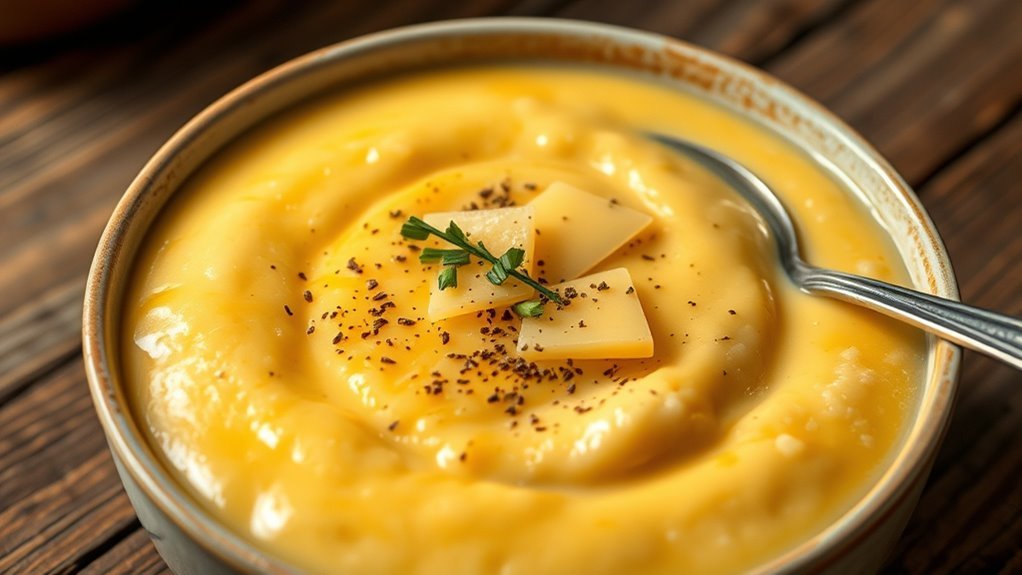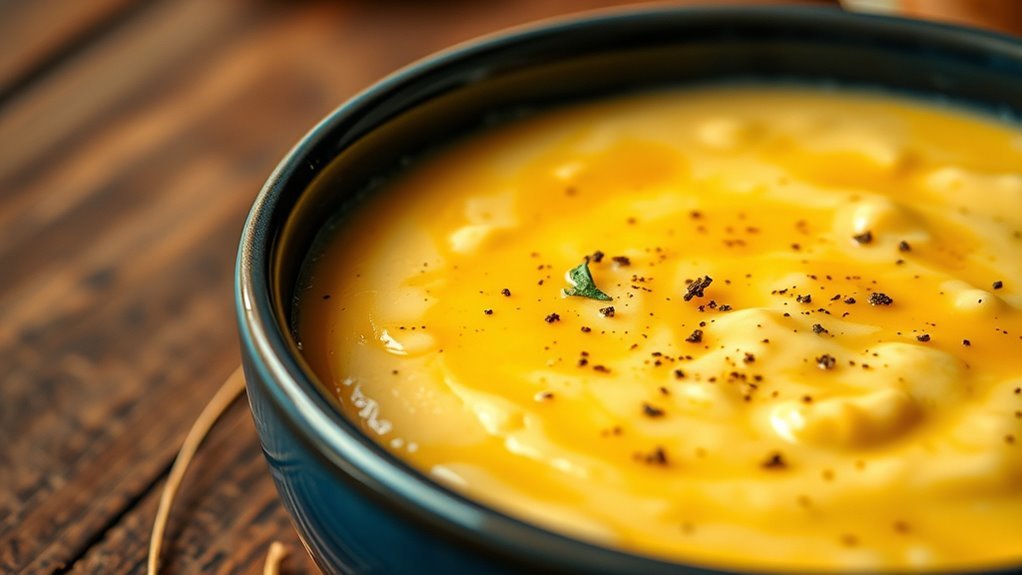Cheese grits aren’t keto-friendly due to their high carbohydrate content, which can range from 20-30 grams per serving. Traditional grits are even worse, packing 73 grams of carbs per 100 grams. Since the ketogenic diet prioritizes low carb intake to promote fat adaptation, indulging in cheese grits can hinder your progress. However, there are numerous alternatives and creative modifications available to satisfy your comfort food cravings while aligning with your keto goals that you might want to explore.
Understanding the Ketogenic Diet

While many people are drawn to the ketogenic diet for its potential weight loss benefits, understanding its foundational principles is essential for success. At its core, the ketogenic diet emphasizes low carbohydrate intake, which shifts your body into a state of fat adaptation. This means your body starts to rely on fat as its primary energy source rather than glucose. Embracing ketogenic principles, like consuming high levels of healthy fats and moderate protein, helps facilitate this transformation. Research shows that fat adaptation can enhance mental clarity and energy levels, offering a sense of freedom from the constant cycle of hunger. By grasping these principles, you can optimize your ketogenic journey and access its full potential for overall health and well-being.
Nutritional Profile of Traditional Grits

When considering traditional grits, it’s essential to analyze their nutritional profile, particularly their carbohydrate content, which is remarkably high. You’ll also find that grits offer some protein and fiber, alongside various vitamins and minerals. Understanding these elements can help you gauge how grits fit into your overall dietary goals.
Carbohydrate Content Analysis
To understand whether cheese grits fit within a keto diet, it’s essential to analyze the carbohydrate content of traditional grits. Grits are primarily made from corn, making them a significant carbohydrate source. Let’s break down the nutritional profile:
| Nutrient | Amount per 100g | Comments |
|---|---|---|
| Total Carbohydrates | 73g | High in carbs |
| Fiber | 3.9g | Minimal fiber content |
| Sugars | 0.8g | Low sugar content |
| Protein | 9.1g | Moderate protein source |
| Fats | 1.5g | Negligible fat content |
Given this analysis, traditional grits aren’t a viable option for those seeking grits alternatives on a keto diet. The carbohydrate content simply exceeds keto guidelines.
Protein and Fiber Levels
Understanding the protein and fiber levels in traditional grits is essential for evaluating their overall nutritional value. Typically, grits provide minimal protein, offering about 2 grams per serving, which isn’t sufficient as a primary protein source. While you might enjoy grits as part of a balanced meal, relying solely on them for protein could be limiting.
On the other hand, grits contain a small amount of fiber, around 1 gram per serving. While this isn’t high, fiber benefits, such as improved digestion and increased satiety, still apply. To enhance your meal, consider pairing grits with other protein sources, like eggs or cheese, to create a more nutritionally complete dish that aligns better with your dietary goals.
Vitamins and Minerals Present
While grits may not be a significant source of protein or fiber, their nutritional profile includes various vitamins and minerals that contribute to overall health. You’ll find that traditional grits contain essential B vitamins like thiamine and niacin, which play important roles in energy metabolism and vitamin absorption. Additionally, grits provide minerals such as magnesium, phosphorus, and iron, enhancing their mineral density. These nutrients are fundamental for bone health, energy production, and red blood cell formation. While grits should be consumed in moderation on a keto diet, their vitamin and mineral content can complement a balanced eating plan, especially when paired with nutrient-dense ingredients like cheese or vegetables. Embracing this knowledge empowers you to make informed dietary choices.
Carbohydrate Content of Cheese Grits

Although cheese grits can be a comforting and flavorful dish, their carbohydrate content raises questions for those following a keto diet. Grits are primarily made from ground corn, which is a significant carbohydrate source. A typical serving can contain around 20-30 grams of carbs, making them less suitable for a low-carb lifestyle. Here are some grits variations to contemplate:
- Creamy, cheesy goodness that melts in your mouth
- A savory blend with herbs and spices
- Crispy baked grits for a delightful texture
- Sweet versions topped with fruit or syrup
- Loaded with bacon or sausage for a hearty meal
For those on keto, it’s crucial to weigh these options carefully against your daily carb limit, as cheese grits may disrupt your dietary goals.
The Role of Cheese in a Keto Diet
Cheese can be a valuable part of your keto diet, offering essential nutrients like calcium and protein while being low in carbohydrates. However, not all cheeses are created equal, so it’s important to choose varieties that align with your dietary goals. Additionally, practicing portion control is vital to guarantee that you’re getting the benefits without exceeding your daily carb limits.
Nutritional Benefits of Cheese
When considering the role of cheese in a keto diet, it’s essential to recognize its rich nutritional profile and how it aligns with the diet’s macronutrient requirements. Cheese not only adds flavor but also offers several health benefits that support your keto journey:
- High in healthy fats, promoting satiety
- Rich in protein, aiding muscle retention
- Contains calcium for bone health
- Packed with vitamins A and B12 for energy
- Offers probiotics in certain cheese varieties, enhancing gut health
Incorporating cheese into your meals can enhance your overall nutrition while keeping your carb intake low. Understanding the variety of cheeses available can help you make informed choices that align with your goals, ensuring you enjoy the freedom of flavorful options on your keto diet.
Cheese Types for Keto
Selecting the right types of cheese can greatly enhance your keto diet, as not all cheeses are created equal regarding carbohydrate content. When choosing cheese, you’ll want to focus on cheese varieties that are low in carbs and high in fat to keep you in ketosis. Here’s a quick reference table to help you identify the best keto cheese options:
| Cheese Type | Carbs (g per 1 oz) | Fat (g per 1 oz) |
|---|---|---|
| Cheddar | 0.4 | 9 |
| Gouda | 0.6 | 8 |
| Parmesan | 0.9 | 7 |
| Cream Cheese | 1.2 | 8 |
| Mozzarella | 1.0 | 6 |
These keto cheese options can help you enjoy flavor while maintaining your low-carb lifestyle.
Portion Control With Cheese
While cheese can be a delicious addition to your keto diet, managing portion sizes is essential to guarantee you stay within your daily carbohydrate limits. Different cheese varieties can vary in carb content, so being mindful of how much you consume can help you maintain your desired ketosis.
Consider these points for portion control:
- A single slice of cheddar packs flavor without the carbs.
- Cream cheese can elevate your dishes in small amounts.
- Fresh mozzarella offers a light, creamy option.
- Parmesan sprinkles can add zest while keeping carbs low.
- Brie provides indulgence in moderate portions.
Keto-Friendly Alternatives to Grits
Although traditional grits are off the table for those following a keto diet, there are several delicious alternatives that can satisfy your cravings without jeopardizing your carb count. Consider using cauliflower rice as a base; it’s low in carbs and has a similar texture. Zucchini noodles or konjac noodles offer a pasta-like option, perfect for savory dishes. For a rich, creamy experience, try mushroom risotto made with cauliflower or eggplant puree. Spinach mash is another excellent choice, providing a nutritious, flavorful side. If you’re in the mood for something sweet, pumpkin puree can add a delightful twist to your meals. Almond flour can also be used to create keto-friendly variations of your favorite comfort foods, keeping your diet on track.
Creative Modifications for Cheese Grits
If you’re craving cheese grits but want to stick to your keto diet, there are several creative modifications that can help you enjoy this classic dish without the carbs. Consider these options:
- Alternative bases: Swap traditional grits for cauliflower rice or zucchini noodles.
- Ingredient swaps: Use almond flour or coconut flour for a thicker texture.
- Flavor enhancements: Add spices like garlic powder or smoked paprika for depth.
- Creative toppings: Top with crispy bacon, sautéed mushrooms, or avocado slices for an extra kick.
- Cooking methods: Try baking your dish for a crunchy top or using a slow cooker for creaminess.
Enjoying Comfort Foods on a Keto Diet
Comfort foods often evoke feelings of nostalgia and satisfaction, but many traditional options can be high in carbohydrates, making them unsuitable for a keto diet. However, you can still enjoy these beloved dishes in a guilt-free way. By substituting high-carb ingredients with low-carb alternatives, you can recreate the flavors you love without derailing your diet. For instance, using cauliflower instead of rice or zucchini noodles in place of pasta can satisfy those comfort food cravings while keeping your carb count low. Additionally, incorporating healthy fats like cheese or avocado can enhance flavor and improve satiety. Embracing these modifications allows you to indulge in comfort foods while staying committed to your keto lifestyle, proving that you don’t have to sacrifice enjoyment for health.
Frequently Asked Questions
Can I Use Almond Flour Instead of Grits for a Keto Dish?
Using almond flour instead of grits for a keto dish is like swapping a summer breeze for a rejuvenating ocean wave; both can bring a delightful experience. Almond flour is a great keto-friendly substitute, lower in carbs than traditional grits. If you’re exploring almond flour alternatives, consider options like coconut flour or flaxseed meal for added variety. These substitutes maintain a satisfying texture while keeping your dish within keto guidelines, allowing culinary freedom without compromising your diet.
How Can I Make Cheese Grits Without Corn?
You can make cheese grits without corn by using cauliflower mash as a base. Simply steam and blend cauliflower until smooth, then stir in cheese for that creamy texture. If you’re looking for a different twist, consider zucchini noodles tossed with cheese, which can mimic the consistency of grits while keeping it low-carb. Both options offer a great way to enjoy cheesy goodness without the corn, allowing you the freedom to stay on track with your dietary goals.
Are There Keto-Friendly Brands of Pre-Made Cheese Grits?
Yes, there are keto-friendly brands of pre-made cheese grits! Curiously, the low-carb market has seen a 30% increase in popularity over the last year. Brands like “Good Dee’s” and “Nutritional Revolution” offer delicious keto options that cater to your dietary needs. When you’re looking for convenience without compromising your lifestyle, these pre-made options can save you time and keep you on track with your keto journey. Enjoy guilt-free comfort food!
What Cheeses Are Best for Keto-Friendly Cheese Grits?
For keto-friendly cheese grits, consider using cheeses like cheddar, cream cheese, or mozzarella. Cheddar offers a sharp flavor profile that enhances the dish, while cream cheese provides a creamy texture, making it rich and satisfying. Mozzarella adds a mild taste, perfect for balancing bolder flavors. Combining these cheese types can elevate your grits, giving you the freedom to explore different tastes while sticking to your keto goals. Enjoy experimenting with these delicious options!
How Can I Add Protein to Cheese Grits on a Keto Diet?
To add protein to your cheese grits on a keto diet, consider incorporating high-protein sources like cooked bacon, shredded chicken, or crumbled sausage. These toppings not only boost protein but also enhance flavor. You could also mix in some cottage cheese or Greek yogurt for creaminess and an extra protein punch. Experiment with keto-friendly toppings like avocado or nuts for added texture, while still keeping it within your dietary goals. Enjoy!


